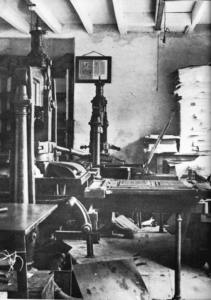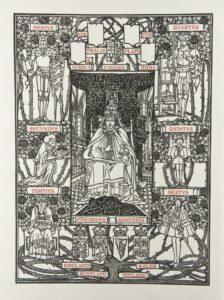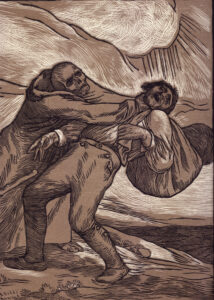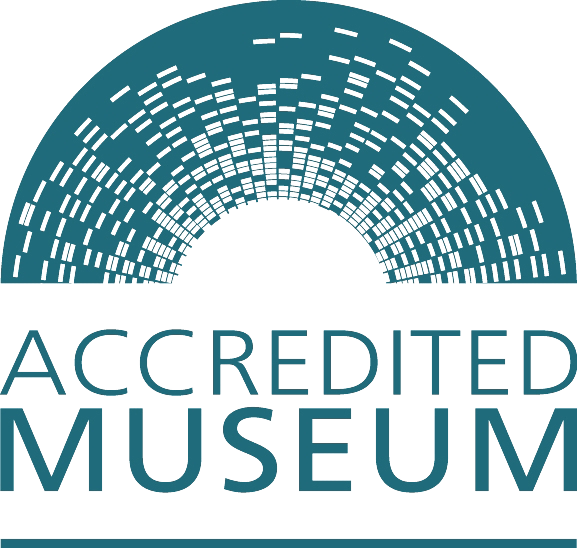
Fine printing for its own sake: this was the ideal of the many private presses in Britain around 1900. Their owners relished the freedom to work by hand on cast-iron presses similar to the wooden press devised by Gutenberg in the fifteenth century. Hand-made paper – or even vellum (calf skin) – could be used, and the typefaces might be specially designed. The print could look black and solid on the page, or be relieved by illustrations or decorations, perhaps with colour added by hand after printing.
These craft ideals appealed to C. R. Ashbee, the architect and designer, who had founded a group of craft workshops in 1888 in the East End of London, making furniture and metalwork. In 1898, when William Morris’s famous Kelmscott Press was closing down, Ashbee welcomed the opportunity to acquire two of its presses and establish the Essex House Press. Court Barn has a collection of over eighty Essex House Press books, demonstrating the range which the Press produced. Some were workmanlike books, intended to inspire, instruct or entertain the Guildsmen, like Ashbee’s translation of Benvenuto Cellini’s Treatises on Goldsmithing and Sculpture, or, in lighter mood, the Guild Songbook. Others were more elaborate, as outlined below.

These are small books, each devoted to a single poem, often by one of the Romantic poets and chosen by Ashbee. The 14 volumes published between 1900 and 1906 were lavishly produced, printed on vellum, with an illustrated frontispiece by a recognised artist. This could be coloured by hand and the text decorated with hand-drawn, coloured initials. The binding was vellum, embossed (‘blind-stamped’) with a design by Ashbee, containing the words ‘Soul is Form’. However, the quality was uneven, in part because Ashbee’s printers, producing 120-150 books at a time, could not give the vellum the special care it needed (vellum has an inner smooth side and an outer roughened side, which print differently).

Being a practising architect and designer, Ashbee was inspired to join the fight to save Wren’s churches in the City of London from destruction. In 1903, as a weapon in this fight, Ashbee published an edition of the eighteenth-century Life and Works of Sir Christopher Wren, with modern illustrations of Wren’s City churches by the topographical artist E. H. New.
Three years later, in A Book of Cottages and Little Houses, Ashbee pulled together details of some of his own architectural work in the Home Counties, Ellesmere Port, and in Chipping Campden. The book was a contribution to the debate on housing, but was also an advertisement for his work. It was enriched with drawings by two of the leading architectural draftsmen of the day: E. H. New, a native of Evesham, and F. L. Griggs, who had lived in Chipping Campden since 1903.

Later, Modern English Silverwork provided a survey of all Ashbee’s work in precious metals, shown in a hundred beautifully simple lithographed drawings. Then The Private Press: A Study in Idealism documented the work of the Essex House Press. Both books were celebrations of many years of creative work, but they were also a kind of farewell, for the Guild of Handicraft went into liquidation in 1908.
Although he was not much of a churchgoer, Ashbee printed two books connected with worship and the Church of England. In 1901 there was an edition of The Psalter, in which each psalm began with a large initial letter, containing a scene suggested by the wording of the psalm. The words were those of Cranmer’s Bible of 1540, the initials recalled Holbein, but many of the scenes he drew came from his own modern, secular imagination.
The Prayer Book of King Edward VII, which Ashbee published in 1903 to celebrate the new monarch, embodied for him the spiritual history of the English people. The size is folio (14” x 10½”) and the pages are visually rich, with two typefaces, one specially designed for the book. The cover is made of oak boards fitted with hammered iron and leather clasps made by the Guild of Handicraft. There are many illustrations, all by Ashbee, which can suddenly surprise you because they are taken from everyday life. For example, the Commination Prayers are a list of divine threats against sinners. At the head of this section Ashbee drew a carpenter in bowler hat and braces hurling rocks at an unaware King David. He commented that in our own time the denunciations ‘are best gathered from the lips of Socialistic workmen’.

Most of the illustrations in Essex House Press books were wood engravings, a nineteenth-century picture-making process which went out of commercial use in the 1890s. Artists and private-press printers then took it up, and in this spirit Ashbee occasionally published wood engravings as prints or images in their own right, without any text. The most ambitious was William Strang’s series of twelve engravings, The Doings of Death (1901). This took its inspiration from Holbein’s famous series of woodcuts, The Dance of Death (1526), though Strang’s figures are more ghoul-like than Holbein’s busy skeletons.

The standard binding for most Essex House Press books was either limp vellum or paper-covered boards. In the early days of the Press, before the move to Campden, Ashbee offered special bindings by Douglas Cockerell, a leading Arts and Crafts book binder. One such binding, made for Ashbee, survives in our collection. Look for the leaf of an ASH tree and a BEE in the central roundel.

In 1902 a bindery was started in Campden alongside the Press, under the care of Statia Power, a pupil of Cockerell’s. A prospectus of October 1902 announced bindings in various leathers, in ebony, rosewood and holly, and in silver with enamels. Sadly, we do not know where any of these special bindings now are. But perhaps some day one will turn up in a collection, an antiquarian bookshop or saleroom…
+44 (0)1386 841951
admin@courtbarn.org.uk



October – March
Tuesday – Sunday 10am – 4pm
April – September
Tuesday – Sunday 10am – 5pm